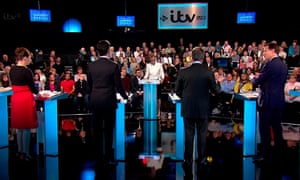For the vast majority of the electorate, TV news remains the main portal through which they experience a general election. For the parties campaigning, getting their message out on the nightly bulletins is still a priority.
Our research shows that in the first week of official campaigning between 30 March and 5 April, election coverage occupied half of all airtime on the major UK broadcasters’ evening bulletins. Both ITV and Channel 4 dedicated more than half of their flagship news programming to the first week of campaigning, but the election was the major story of the week for all, accounting for 45 to 49% of coverage on the BBC, Channel 5 and Sky News. Of the 389 news items during the week 151 had an election theme, despite some major international news stories, such as the Germanwings crash and atrocities in Kenya.
There were notable peaks and troughs in the overall amount of election news, with coverage dipping mid-week, then peaking on the day of the TV leaders’ debate, and picking up again when news broke about the leaked memo alleging the SNP’s Nicola Sturgeon favoured a Conservative victory. The ebb and flow of the campaign, in particular the impact of the seven-way leaders’ debate, had a clear impact on the issues TV news coverage focused on. The majority of airtime was spent debating non-policy issues – 61% in total – with the debate accounting for a quarter of coverage. News generally about party campaigning made up almost 10% of coverage, while the leaked memo story amounted to nearly 6% of the total week’s news on its own.
Of the policy issues that did make it into election news, the handling of the economy was the standout topic. More specific economic issues, such as unemployment and jobs or levels of taxation, were covered far less. Meanwhile, other social issues that voters consider important – including the NHS, education and housing – barely registered. Since polls appear to indicate voters most trust David Cameron’s government with the economy, this might be viewed as an early victory for Conservative party campaign strategists.
When it comes to how each of the parties fared, there were clear winners and losers. Of the seven parties involved in the TV leaders’ debate, Conservative sources were granted the most airtime in bulletins. Cameron did even better than his party overall, getting more than a third of all airtime dedicated to leaders, though Ed Miliband and Nick Clegg were not far behind. The Greens and Natalie Bennett received the least airtime, less proportionally than their support in the polls, which hovers around 5%. Again the debate clearly had an impact. Beforehand, the so-called minor parties and their leaders were given little airtime. Post-debate they were afforded far more, with the SNP – due also to the memo story – receiving a similar level of coverage to Ukip despite not being considered a “major UK party” by regulators. Of course, campaign coverage needs to be assessed over a far longer period before making judgments about broadcasters’ impartiality.
TV news doesn’t operate in a vacuum. But while there has been a lot of hype about the power of social media campaigning, our analysis suggests newspapers had a big impact on the agenda during the election’s official first week, with the Daily Telegraph’s influence especially apparent. It was a letter to the Telegraph from 103 business leaders supporting the Tories on 31 March that propelled the economy to lead the news. Whether the letter should have received such prominence is debatable, however. Earlier in the week, a poll revealed two thirds of leading economists disagreed with the government’s austerity measures, but that received far less attention.
The paper’s influence on news priorities was underlined further after its 4 April splash about the Sturgeon memo. The issue led every bulletin that night – the day after the SNP leader’s widely praised performance in the debate.
But it was the debate that received most coverage in the first week. Although much of it was predictably about which leader had “won”, ITV’s hustings also led to a greater range of policy perspectives being aired on the UK’s flagship bulletins. With two more high-profile programmes coming up – a challengers’ debate on Thursday and a Question Time special on 30 April with Cameron, Miliband and Clegg – it could be that the performance of party leaders in different TV formats has a decisive agenda-setting role as election day draws closer.
The Cardiff University study examined bulletins on Channel 5 at 5pm, Channel 4 at 7pm and at 10pm on BBC, ITV and Sky News. Research by Richard Thomas, Allaina Kilby and Marina Morani

View all comments >
comments
Sign in or create your Guardian account to join the discussion.
This discussion is closed for comments.
We’re doing some maintenance right now. You can still read comments, but please come back later to add your own.
Commenting has been disabled for this account (why?)